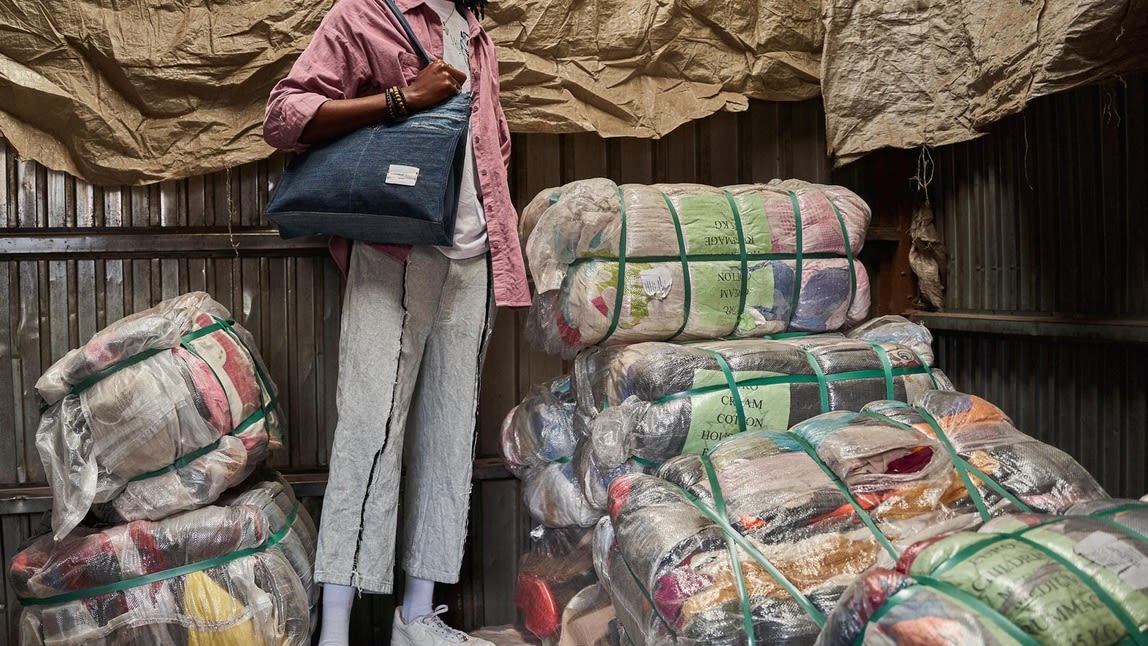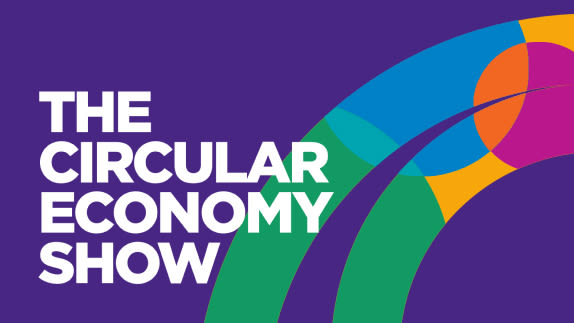In the last episode of our series sharing some of the Ellen MacArthur Foundation's most popular articles, we explore the world of reuse and repair. Travelling to the African continent, we find out how people and businesses have been embracing strategies to maximize material use for a long time
Reuse and repair are critical aspects of a circular economy, but despite clear benefits, they've yet to gain a foothold in the Global North. Whilst greater awareness and new legislation are beginning to shift the needle, driving better use of products and materials in the North, African companies have long been applying creative and innovative approaches to maximise material usage. So what can be learnt?
Listen on Spotify, Apple Podcasts, or wherever you get your podcast.
Transcript
Pippa Shawley 00:03
Reuse and repair a key leaps in a circular economy, keeping products and materials in use and avoiding waste. But despite the clear benefits of these functions, the global north is still hooked on disposability. Although greater awareness and new legislation are beginning to drive better use of products and materials in the north, societies and Africa have long embraced strategies for maximising materials. So what can be learned? I'm Pippa, and in today's episode, I'm sharing an article by my colleague Laura Collicott, freelance editor here at the Ellen MacArthur Foundation, which explores how Africa's skills in repair and repurposing, pointing the way for the Global North.
Finley Phillips 00:50
In Africa, we have been practising the circular economy for centuries
Pippa Shawley 00:54
Says Ghislain Irakoze.
Finley Phillips 00:57
People don't know it, but that's the reality.
Pippa Shawley 00:59
Irakoze is CEO and founder of Wastezon a Rwanda based company which repairs and re manufactures electronics and resells quality assured products back into the market. The company sprung from a near tragedy amid Africa's growing waste problem.
Finley Phillips 01:17
When I was on a school assignment with my best friend, a heap of garbage fell on him. He was hospitalised for almost three months that inspired me to explore solutions that could divert waste from landfill.
Pippa Shawley 01:29
Across the continent. African companies take a creative innovative approach to material sourcing that places less emphasis on Virgin raw materials. Fashion is a key market where this approach can be seen in action. Soul rebels in Ethiopia, make shoes out of recycled tires, indigenous plant fibres and local leather. Nigeria’s Planet 3R weaves discarded plastic water sachets into bags, homewares, and accessories. Nairobi-based Rummage Studio sources 95% of the core materials in its bags and accessories from the largest second hand textile market in East Africa: Gikomba.
Joe Iles 02:09
We tend to use anything that has a nice pattern and looks durable.
Pippa Shawley 02:13
Says founder Muhammad Awali.
Joe Iles 02:15
We like to put that back into the market, give it a second life and assure people that it's going to last a long time. For us upcycling is not a limitation, but a constant integration that pushed us to find creative solutions every step.
Pippa Shawley 02:28
These solutions prove economically viable too. Each of these companies have found financial success and are looking to scale. From a standing start in 2005, Sole Rebels has global reach, stores in North America and Europe, and an annual revenue of USD 22 million. Planet 3R employs 16 full-time staff after less than 3 years in operation, and secured USD 100,000 funding to expand. Rummage Studio rebranded from its original name of Suave Kenya to appeal to its increasingly international customers. But as well as these established businesses, a huge cohort of talented industrious craftspeople work to repair and repurpose products from solar panels to shoes, often with limited infrastructure or resources. Bicycle mechanics travel between towns to collect worn out bikes and salvage gear sets and brake cables for repairs. seamstresses, patch shirts hemmed trousers and make bow ties from leftover cloth. Artists make jewellery out of electronic waste. Almost everything can be repaired, noted a foreign commonwealth and Development Office funded study led by the Better Futures colab last year, landscaping the repair and reuse economy in Kenya.
Lou Waldegrave 03:49
Africa in particular has a rich tradition of resourcefulness repair and repurposing, driven by the necessity of limited resources and self sufficiency,
Pippa Shawley 04:01
says Kelly Rowe the reports co author.
Lou Waldegrave 04:04
Entrepreneurs in Africa often view waste as a valuable resource that can be utilised for repair and refurbishment or transformed into new products. chairs made from upcycled tires for example, waste is considered a valuable resource.
Finley Phillips 04:23
Consumption behaviour is structured so that all materials can also be a resource for the future.
Pippa Shawley 04:28
Affirms Irakoze.
Finley Phillips 04:30
In emerging economies with low incomes, money isn’t at their disposal to buy brand new things.
Pippa Shawley 04:36
It could be argued that waste is a wealth problem. As consumerism boomed in the 1950s and 1960s. In a family linear fashion, the disposable society took root in the Global North, it became cheaper and easier to throw a broken kettle away than to find the parts or skills to fix it. Since the linear model depends on a take make waste approach as consumerism grew waste and pollution proliferated.
Finley Phillips 05:03
The economy plays a role.
Pippa Shawley 05:05
Irakoze reflects.
Pippa Shawley 05:06
But I'd rate consumer behaviour as the key enabler, people are interested in reusing and repurposing products.
Pippa Shawley 05:13
Recognising that many countries in the Global South instead have well established markets for repair and reuse the better futures. colab repair and reuse study explored the economic benefits of these activities taking Kenya as a case study. It found that the repair market in the country is worth a minimum of 1.5% of Kenya's economy, equating to around 1.5 billion US dollars. A conservative estimate given that much of this takes place in the hard to measure informal sector known in Kenya as the DUA Kali, which translates literally as fear son, but it has come to signify the small scale traders, entrepreneurs, artisans and vendors who often operate in the open air. Socially, this sector is worth even more, accounting for approximately 83% of total employment in the country, and creating more than 90% of new jobs. According to the Kenyan Bureau of Statistics, there's a lot to be learned from the artisans of Africa. And these talents are vital for advancing a circular economy globally. Repair and repurpose strategies are essential but frequently overlooked functions of the sector economy key to circulating products and materials at their highest value. By keeping products and when they can no longer be used, their components and raw materials in use, nothing becomes waste and the intrinsic value of products and materials is retained. Although designing out waste in the first place is the priority. By extending the life of existing products through repair and repurposing materials are kept in the economy and out of the environment. Developing these leaps brings economic benefits. Adopting value retention processes is a win win situation for governments, industry and customers. According to the UN Environment Programme, governments would have less waste to deal with generate green jobs and stimulate economic growth. Industry could lower production costs, avoid resource constraints on business growth, and open new markets and customers could benefit from lower prices for refurbished products. The economic advantage is key. Some estimates put the annual growth of the repair and maintenance sector as high as 8.5% in 2023, with a total global value of 1530 6 billion US dollars. Jobs are also a big draw for policymakers. The United States Environmental Protection Agency calculates that of every 10,000 tonnes of US goods, while putting them in landfill creates around six jobs. recycling them were create 36 jobs and reuse and repair could create up to 296. Meanwhile, a UK study found that transforming the UK is approach to repair, reuse, recycling and re manufacture could create more than 450,000 jobs across the country by 2035. The Global North is beginning to return to these loss values, driven by an awakening to the damage caused by our wasteful economy and the cost of living crisis. A trend to mend has been identified in the UK. In Germany, repair initiatives have been proliferating across the country. In Copenhagen resource Rose is building an entire new urban development from resources that would normally have been considered waste. From community repair cafes now numbering more than 2500 around the world, to disruptive digital startups such as sojo, which aims to make repairs accessible from your smartphone, and major corporate repair offerings from the likes of Apple and Tommy Hilfiger. Repair is increasingly ala mode. Even celebrities are lending their weight to more circular consumption. Angelina Jolie's recently launched Atelier Julie links consumers with tailors to make individual products using leftover quality vintage material and deadstock. Although in African countries the sector has grown organically, and still exists largely outside policy frameworks in the Global North policy is beginning to move in support of these approaches. In March 2023, the European Commission adopted a right to repair proposal, which will make it easier and more cost effective for consumers to repair as opposed to replace goods. In North America, Canada announced a plan to implement the right to repair for electronic equipment in 2024. And Colorado passed the first right to repair legislation for agricultural equipment in April last year. So what can the global north learn from Africa as it reestablishes the sidelines sectors? Here are four ways to embed, repair and repurpose mindset change. The very first priority is a mindset shift. companies and consumers in the Global North must continue to reevaluate that attitude towards repaired and repurposed products. It's a process that's already underway. The popularity of remanufactured automotive parts has grown and acceptance of reconditioned electronic goods is also increasing. Europe's refurbished mobile phone market, for example, is projected to grow by almost 10%, a year between 2023 and 2033. However, for the segment to reach the necessary scale to cement a circular economy and place refurbished goods across the board need to be as attractive as new ones. Appealing to consumers growing sustainability sensibilities to make refurbished goods cool is one way of boosting sales, and one that has already borne fruit in the booming pre loved clothing market, where buying secondhand has gone from niche to mainstream that the UK is popular reality TV show love Island has switched from a fast fashion sponsor to eBay is testament to the changing status of the resale sector. With Harry Styles stylists launching a Depop store, Olivia Rodrigo popping on the app to sell her clothes, and 10s of billions of Tiktokers celebrating the power of the old in fashion. It is clear that the resale sector has not only found its space, but it's here to stay. In Africa, consumers are starting to view these products as positively as new ones. In Nairobi, a widely believes young people are driving the segment.
Joe Iles 11:39
They see the craftsmanship and quality of our products and compared to the inputs they are buying. Upcycled products are cool and original and they last longer.
Pippa Shawley 11:48
Skills Training. Access to skills is critical.
Joe Iles 11:52
We're really big on crafts.
Pippa Shawley 11:53
Says Awale.
Joe Iles 11:54
It could be woodwork, metalwork, or tailoring. If you've got an idea you want to try out and you can't make it you can find some of the neighbourhood who can.
Pippa Shawley 12:03
The same access does not exist in the blue collar economies of the Global North. And the International Labour Organisation has already identified skills gaps as a bottleneck for green growth in a number of sectors, training more people in repair and artisanal skills, and finding ways to connect cross people with consumers nearby is key to developing the sector. Convenience, it's got to be easy. The Better Futures colab repair and reuse study found that consumers were generally willing to repair broken items. However, their intentions could easily be hampered if repairs were seen to require too much effort compared to replacement African markets and high streets throng with stores offering repair services. Generally, such hyper localised repair communities are the first port of call for customers, enhancing these can promote their use. Similarly, creating effective infrastructure for collecting, sorting, and redistributing products that have life extension potential is vital to divert usable materials from landfill. Essentially, in order to scale these operations up time poor consumers need to know where to drop products, repairers and re purposes need to be able to easily find and collect them. Certification. To keep returning to repair services, customers need to trust the quality of the work. Certification can be vital in this regard.
Finley Phillips 13:31
Both security and quality vetting are instrumental in promoting this reuse and repurposing culture.
Pippa Shawley 13:39
Says Irakoze.
Finley Phillips 13:39
These are some of the biggest challenges we scoped in this market. Our refurbishment lab checks device components and checks their durability and security.
Pippa Shawley 13:48
Verifying workmanship in this way is crucial to building a consumer base and growing the sector. Africa has an established culture of repurposing materials, but the system is not perfect. challenges exist around the quality of repairs. trust between consumers and businesses. A lack of policy support and as wealth increases a growing trend towards the same disposable consumerism seen in the Global North. The continent currently generates less waste than much of the rest of the world. But if current trends persist, Sub Saharan Africa is forecast to become the biggest global producer of waste. The continent can avoid making the same polluting mistakes as the global north by preserving and enhancing existing talents for repair and repurpose. Rowe points out that:
Lou Waldegrave 14:39
Europe has far greater advancements and policies, regulations and infrastructure promoting the circular economy and encouraging repair and reuse practices.
Pippa Shawley 14:51
For example, the EU eco design rules require that spare parts are available for a product for a certain amount of time. Although both Global North and global south face unique challenges and opportunities. By harnessing the best practice of each region, the repair and repurpose sector could take critical strides forwards. Key areas for development include standards waste on has identified the need to reassure that customers with guaranteed workmanship. But providing this reassurance at a national or regional scale has the potential to accelerate uptake of the sector. centralise certification and regulation can level the playing field and build consumer confidence in the repair and repurpose sector. Legislation legislating for such capacity changes the governance structure of the repair industry, rather than manufacturers deciding which products are repairable or not. By creating a centralised set of standards and mandating access to competitive services, consumers and independent repair businesses can contribute to the development of the sector. But ro cautions that such standards should not force the formalisation of activities.
Lou Waldegrave 16:03
It's through formalisation that repair can become a very exclusive experience, particularly for those that have existed in the informal part of the economy for decades.
Pippa Shawley 16:14
As yet the way forward for this isn't clear, but it will be the subject of rows next study and hopefully provide crucial learnings for such collaborations across geographies and sectors. Accessibility, spare parts have to be easily accessible. Technology can help here. 3d printing, for example, can make a huge catalogue of parts available to tradespeople around the world. Digital parts tracing can improve transparency in availability and pricing of spare parts. A Brazilian platform spare track aims to do just this. However, the reliance on online systems requires reliable and accessible internet systems with the risk of deepening the digital divide. Innovation interventions in this regard need to be sensitive to the availability of online connections. Data:
Lou Waldegrave 17:06
There's just no data on repair says row. For me it's another big area of opportunity. Imagine if we had enough data and insights to understand the repair and reuse economy across the entire continent and world. They'd brands and businesses want to commit, but they struggle to know where and how.
Pippa Shawley 17:26
Data could surface the extent of the opportunity, the gaps the success factors, and support businesses and the development of new business models and services. Talent hubs, rather than each national economy working to become a jack of all trades, the concept of value pools based on existing strengths, holds weight in the repair and repurpose sector. Developing regional hubs for repair could play to current localised talents, and provide a pathway to scaling up hyper localised approaches where appropriate, driving reciprocal trade within those regions. For example, a broken computer can be taken to a local collection centre by the consumer then shipped to a central repair hub for specialised repair before being returned to the collection point. Policy and incentives. policies such as extended producer responsibility, and a right to repair, create push factors impelling businesses to create more robust products and provide repair infrastructure. In countries such as Slovenia and Sweden, governments have slashed VAT on repair services. France's repairability index mandates the display of clear repair information for electronic equipment. A framework of such policies tailored to regional geographies, can set the enabling conditions that allow the repair and repurpose industries to flourish. As the limitations of the linear economy have become more apparent, the resourcefulness and creativity of Africa could be leveraged in accelerating the transition to a circular economy. Repair and reuse largely occur as secondary activities in the Global North rather than as an integrated aspect of an overall product or sector strategy. But countries here are waking up to their importance. By studying the thriving, repair and repurpose sectors in Africa, and translating the success factors their own context. These countries stand to benefit, repair and repurpose industries create employment opportunities, reduce waste and pollution and reduce reliance on natural resources. Meanwhile, African countries could hone their existing talents and borrow from tried and tested enabling policy to quickly progress towards a circular economy. Rowe concludes:
Lou Waldegrave 19:45
Just imagine just how big and effective the sector would be if it had all the right enabling conditions.
Pippa Shawley 19:56
Thanks for listening to this episode of the Circular Economy Show. If you enjoyed this episode, then please leave us a review or share it with your network. If you'd like to read Laura's original article, including links to the organisations and research mentioned, you can find the link in the show notes of this episode. See you next time.





